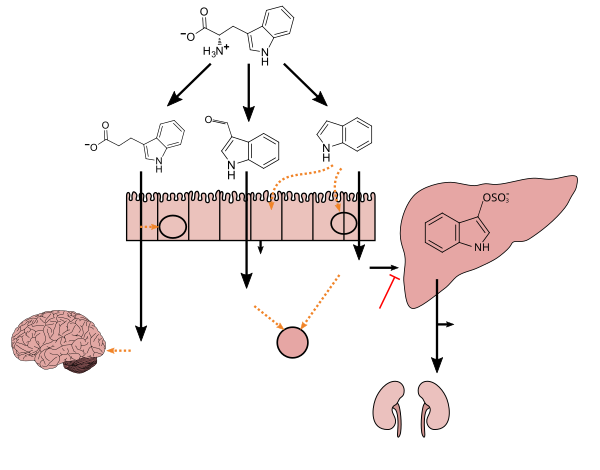Indoxyl sulfate

| |
| Names | |
|---|---|
| Preferred IUPAC name
1H-Indol-3-yl hydrogen sulfate | |
| Other names
3-Indoxylsulfate; 3-Indoxylsulfuric acid; Indol-3-yl sulfate
| |
| Identifiers | |
3D model (JSmol)
|
|
| ChEBI | |
| ChEMBL | |
| ChemSpider | |
| DrugBank | |
PubChemCID
|
|
| UNII | |
CompTox Dashboard(EPA)
|
|
| |
| |
| Properties | |
| C8H7NO4S | |
| Molar mass | 213.21g·mol−1 |
Except where otherwise noted, data are given for materials in theirstandard state(at 25 °C [77 °F], 100 kPa).
| |
Indoxyl sulfate,also known as3-indoxylsulfateand3-indoxylsulfuric acid,is ametaboliteof dietaryL-tryptophanthat acts as acardiotoxinanduremic toxin.[1][2][3]High concentrations of indoxyl sulfate inblood plasmaare known to be associated with the development and progression ofchronic kidney diseaseandvascular diseasein humans.[1][2][3]As a uremic toxin, it stimulatesglomerular sclerosisandrenal interstitial fibrosis.[1][2]
Biosynthesis
[edit]Indoxyl sulfate is a metabolite of dietaryL-tryptophanthat is synthesized through the following metabolic pathway:[3][4][5]
Indole is produced fromL-tryptophanin thehuman intestineviatryptophanase-expressinggastrointestinal bacteria.[3]Indoxyl is produced from indole viaenzyme-mediatedhydroxylationin theliver;[3][4]in vitroexperiments with rat and humanliver microsomessuggest that theCYP450enzymeCYP2E1hydroxylates indole into indoxyl.[4]Subsequently, indoxyl is converted into indoxyl sulfate bysulfotransferase enzymesin the liver;[4][5]based uponin vitroexperiments withrecombinanthuman sulfotransferases,SULT1A1appears to be the primary sulfotransferase enzyme involved in the conversion of indoxyl into indoxyl sulfate.[5]
Tryptophan metabolism byhuman gastrointestinal microbiota()
|
Clinical significance
[edit]Occasionally inurinary tract infections,bacteria produceindoxyl phosphatasewhich splits indoxyl sulfate formingindigoandindirubincreating dramaticpurple urine.[9]Indoxyl sulfate is also a product ofindolemetabolism, which is produced fromtryptophanby intestinal flora, such asEscherichia coli.[10]
References
[edit]- ^abc"Indoxyl sulfate".Human Metabolome Database – Version 4.0.23 October 2017.Retrieved15 November2017.
- ^abc"Indoxyl sulfate".PubChem Compound.United States National Library of Medicine – National Center for Biotechnology Information. 11 November 2017.Retrieved15 November2017.
- ^abcdefghijklmnZhang LS, Davies SS (April 2016)."Microbial metabolism of dietary components to bioactive metabolites: opportunities for new therapeutic interventions".Genome Med.8(1): 46.doi:10.1186/s13073-016-0296-x.PMC4840492.PMID27102537.
Lactobacillusspp. convert tryptophan to indole-3-aldehyde (I3A) through unidentified enzymes [125].Clostridium sporogenesconvert tryptophan to IPA [6], likely via a tryptophan deaminase.... IPA also potently scavenges hydroxyl radicals
Table 2: Microbial metabolites: their synthesis, mechanisms of action, and effects on health and disease
Figure 1: Molecular mechanisms of action of indole and its metabolites on host physiology and disease - ^abcdBanoglu E, Jha GG, King RS (2001)."Hepatic microsomal metabolism of indole to indoxyl, a precursor of indoxyl sulfate".European Journal of Drug Metabolism and Pharmacokinetics.26(4): 235–40.doi:10.1007/bf03226377.PMC2254176.PMID11808865.
- ^abcBanoglu E, King RS (2002)."Sulfation of indoxyl by human and rat aryl (phenol) sulfotransferases to form indoxyl sulfate".European Journal of Drug Metabolism and Pharmacokinetics.27(2): 135–40.doi:10.1007/bf03190428.PMC2254172.PMID12064372.
- ^Wikoff WR, Anfora AT, Liu J, Schultz PG, Lesley SA, Peters EC,Siuzdak G(March 2009)."Metabolomics analysis reveals large effects of gut microflora on mammalian blood metabolites".Proc. Natl. Acad. Sci. U.S.A.106(10): 3698–3703.Bibcode:2009PNAS..106.3698W.doi:10.1073/pnas.0812874106.PMC2656143.PMID19234110.
Production of IPA was shown to be completely dependent on the presence of gut microflora and could be established by colonization with the bacteriumClostridium sporogenes.
IPA metabolism diagram - ^"3-Indolepropionic acid".Human Metabolome Database.University of Alberta.Retrieved12 June2018.
- ^Chyan YJ, Poeggeler B, Omar RA, Chain DG, Frangione B, Ghiso J, Pappolla MA (July 1999)."Potent neuroprotective properties against the Alzheimer beta-amyloid by an endogenous melatonin-related indole structure, indole-3-propionic acid".J. Biol. Chem.274(31): 21937–21942.doi:10.1074/jbc.274.31.21937.PMID10419516.S2CID6630247.
[Indole-3-propionic acid (IPA)] has previously been identified in the plasma and cerebrospinal fluid of humans, but its functions are not known.... In kinetic competition experiments using free radical-trapping agents, the capacity of IPA to scavenge hydroxyl radicals exceeded that of melatonin, an indoleamine considered to be the most potent naturally occurring scavenger of free radicals. In contrast with other antioxidants, IPA was not converted to reactive intermediates with pro-oxidant activity.
- ^Tan, CK; Wu YP; Wu HY; Lai CC (August 2008)."Purple urine bag syndrome".Canadian Medical Association Journal.179(5): 491.doi:10.1503/cmaj.071604.PMC2518199.PMID18725621.
- ^Evenepoel, P; Meijers, BK; Bammens, BR; Verbeke, K (December 2009)."Uremic toxins originating from colonic microbial metabolism".Kidney International Supplements.76(114): S12-9.doi:10.1038/ki.2009.402.PMID19946322.

